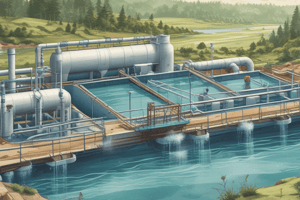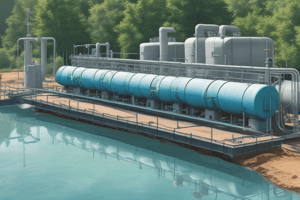Podcast
Questions and Answers
What is the common method of drinking water treatment that removes pathogens and contaminants from the water?
What is the common method of drinking water treatment that removes pathogens and contaminants from the water?
- Disinfection (correct)
- Sedimentation
- Flocculation
- Filtration
What is the main purpose of drinking water treatment?
What is the main purpose of drinking water treatment?
- To remove dissolved oxygen from the water
- To ensure water is of a safe quality for consumption (correct)
- To change the pH level of the water
- To increase the amount of sediment in the water
What is the process of removing suspended particles from the water?
What is the process of removing suspended particles from the water?
- Aeration
- Filtration
- Flocculation
- Sedimentation (correct)
What is the benefit of drinking water treatment in preventing tooth decay?
What is the benefit of drinking water treatment in preventing tooth decay?
What is the purpose of aeration in drinking water treatment?
What is the purpose of aeration in drinking water treatment?
What is the effect of untreated water on human health?
What is the effect of untreated water on human health?
What is the process of forming clumps of particles in the water treatment process?
What is the process of forming clumps of particles in the water treatment process?
What is the final stage of the water treatment process?
What is the final stage of the water treatment process?
What is the purpose of aerating raw water before treatment?
What is the purpose of aerating raw water before treatment?
What is the role of chlorine in water treatment?
What is the role of chlorine in water treatment?
What type of chemicals can be used as coagulants in water treatment?
What type of chemicals can be used as coagulants in water treatment?
What is floc in the context of water treatment?
What is floc in the context of water treatment?
What type of filters are used in drinking water treatment plants?
What type of filters are used in drinking water treatment plants?
Why is hydrated lime added to treated water?
Why is hydrated lime added to treated water?
What is the purpose of aeration in raw water treatment?
What is the purpose of aeration in raw water treatment?
What is the function of sedimentation tanks in water treatment?
What is the function of sedimentation tanks in water treatment?
What is the purpose of the jar test in water treatment?
What is the purpose of the jar test in water treatment?
What is the purpose of coagulation in water treatment?
What is the purpose of coagulation in water treatment?
What is the purpose of disinfection in water treatment?
What is the purpose of disinfection in water treatment?
What is the type of coagulant that is carcinogenic?
What is the type of coagulant that is carcinogenic?
What is the purpose of quality control in a Water Treatment Plant (WTP)?
What is the purpose of quality control in a Water Treatment Plant (WTP)?
What is the device used to measure the pH of the water in a Water Treatment Plant (WTP)?
What is the device used to measure the pH of the water in a Water Treatment Plant (WTP)?
Flashcards are hidden until you start studying
Study Notes
Drinking Water Treatment Process
- The treatment process for drinking water varies depending on the type and quality of the raw water.
- Common treatment methods include aeration, flocculation, sedimentation, filtration, and disinfection to ensure water is safe for consumption.
Aeration of Raw Water
- The purpose of aeration is to remove dissolved gases and metals from the raw water.
Coagulation Process
- Coagulants are added to the raw water to remove dirt and other suspended particles.
- Types of coagulants include alum and ferric late.
- The coagulation process involves mixing the coagulant with the raw water to create floc.
Flocculation Process
- The flocculation process involves the production of floc, which attracts and traps dirt and other suspended particles.
- The floc is then removed from the clear water in sedimentation tanks.
Sedimentation Tanks
- Sedimentation tanks are used to remove the floc from the clear water.
- The clear water is then passed through sand filters to remove any remaining suspended particles.
Filtration
- Water flows downwards through sand filters to remove suspended particles.
- The sand filters trap the floc, allowing clear water to pass through.
Disinfection
- Disinfection involves adding chlorine gas to the clear water to kill pathogens and prevent tooth decay.
Quality Control
- Water treatment plants (WTPs) have quality control laboratories to test the raw and finished water.
- Laboratory tests include bacteriological, physical, and chemical tests to ensure the water meets standards.
- Equipment used in the laboratory includes pH meters, colorimeters, and turbidity meters.
Jar Test
- The jar test is a laboratory procedure that simulates coagulation and flocculation with differing chemical doses.
- The test is used to estimate the minimum coagulant dose required to achieve certain water quality goals.
Water Treatment Technologies
- Conventional treatment process involves aeration, flocculation, sedimentation, filtration, and disinfection.
- Advanced treatment technologies include ACTIFLO (high-speed microsand settling process), DAF (dissolved air flotation), and Ultrafiltration Membrane Systems.
- Other technologies include fluoridation and tablet treatment.
Studying That Suits You
Use AI to generate personalized quizzes and flashcards to suit your learning preferences.




